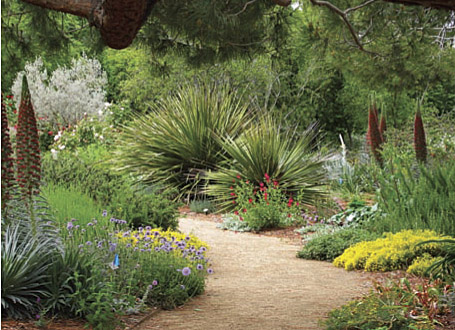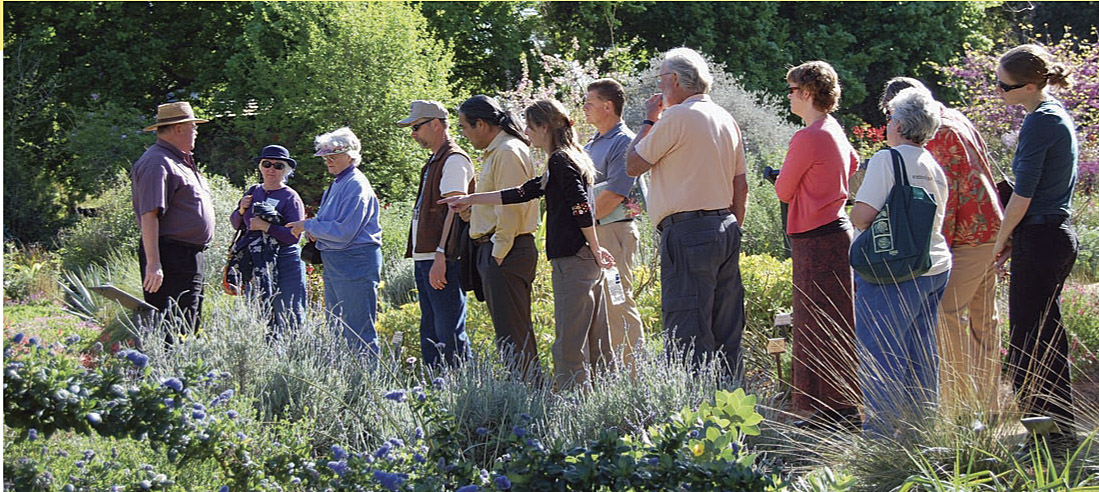All Issues
Safe alternatives to replace invasives in California gardens
Publication Information
California Agriculture 62(3):88-88.
Published June 01, 2008
PDF | Citation | Permissions
Full text
An innovative partnership called “PlantRight” is working to limit the sale of garden plants that can invade natural areas, and instead off er alternatives that are not risky to native ecosystems.
“Nonnative species can cause enormous havoc on the environment,” California Secretary of Agriculture A.G. Kawamura said during the kick-off for PlantRight's public outreach campaign at the UC Davis Arboretum on April 1. “And invasives are our number one threat to food and agriculture in California.”
The current outreach campaign is focused on 19 invasive horticultural plants in the Central Valley that the partnership identified as substantial risks to natural areas. (See www.PlantRight . org for maps covering all of California.)
“We partnered with University of California scientists to answer key questions about invasive plant species,” says PlantRight project manager Terri Kempton of Sustainable Conservation, a nonprofit that collaborates with industry to find solutions to environmental problems. “We based all of our decisions on sound science, which provided neutral ground that we could agree on.”
In 2004, Sustainable Conservation formed a partnership — called California Horticultural Invasives Prevention (Cal-HIP) — with nurseries, retailers, landscape professionals, researchers, gardeners and government agencies. These included UC Master Gardeners, The Nature Conservancy, the California Invasive Plant Council, the American Nursery and Landscaping Association and others.
The problem with invasive plants
With about $3.79 billion in annual production sales in 2006, the nursery industry recently bypassed grapes to become the state's number two agricultural product (after dairy). The goal of Sustainable Conservation's collaborative effort was to reach agreement on invasive plants that shouldn't be sold in certain regions of California — potentially affecting the nursery industry's bottom line.
“We really had to engage the horticultural industry,” says Joseph DiTomaso, UC Cooperative Extension weed specialist. “In the past there had been a lot of reluctance to work together.”
According to Sustainable Conservation, more than half of California's invasive varieties arrived via gardens and landscaping.
A well-known, almost iconic example is ice plant, which proliferates along the California coast. Ice plant species were imported from the Mediterranean as ornamentals and were planted for erosion control. They now grow wild on vast expanses of ocean frontage, choking out native vegetation and increasing the salt content of the soil. California devotes millions of dollars and thousands of volunteer hours every year to control ice plant.
The PlantRight program emphasizes that garden plants need not endanger rare ecosystems to be beautiful and garden-worthy. Above, the UC Davis Arboretum's Storer Garden.
“Invasive plants reproduce at high rates and dramatically alter ecosystems by crowding out native species of plants and animals,” Kempton says. “This is an area where individual choices really affect wildlands.” Invasive plants may also promote flooding and increase fire risks.
For example, brooms are hardy, shrublike species that form dense stands on hillsides, virtually eliminating native habitats and producing up to 12,000 seeds per plant. Instead of invasive brooms, Cal-HIP recommends planting forsythia and four other yellow-blooming plants in the Central Valley. In the place of giant reed, which grows thickly along waterways and ruins bird habitat, Cal-HIP recommends clumping bamboos or New Zealand flax. For scarlet wisteria, a riparian-loving plant that is poisonous to birds, reptiles and mammals, gardeners can plant crape myrtle, island bush snapdragon and several others (see table).
“Fortunately, there are plenty of beautiful, safe alternatives to invasives, so it's easy for gardeners to find plants that meet all their specific needs,” Kempton says.
Developing scientific criteria
DiTomaso notes that of some 60,000 plants in the United States, only several dozen invasive species cause ecological problems in California.
UC scientists helped Cal-HIP develop scientific criteria for defining invasiveness. Carl Bell of UC Cooperative Extension served on the Cal-HIP committee from its inception, and DiTomaso took Bell's place last year. Other UC participants were Holly Crosson of the UC Davis Arboretum and Bethallyn Black of the UC Master Gardener program.
The criteria for defining invasiveness included the plant's distribution, rate of spread, characteristics and reproduction.
“Cal-HIP has taken a good tactic in focusing on plants where science has shown that they're invasive,” Crosson says. “Everyone on the committee feels that the research has to be done and that decisions aren't made unless they are science-based.”
UC researchers have helped to clarify, for example, that all species of pampas grass are invasive, while other studies are looking at interactions between noninvasive sweet broom and highly invasive French broom.
Sustainable, responsible horticulture
PlantRight's current public outreach campaign includes a speakers’ bureau, the distribution of nearly 25,000 brochures and an interactive Web site. UC Master Gardeners and the UC Davis Arboretum will also help to get the word out. “The PlantRight message fits right into the arboretum's messages on sustainable horticulture,” Crosson says. “Being a responsible steward as a gardener means reducing water use, picking plant species that are regionally appropriate and pest- and disease-resistant (see page 97), and not planting invasives.”
Lowe's recently joined the PlantRight effort and is currently reviewing their plant inventory in California stores. Other ”big-box” retailers are expected to follow suit, Kempton says. With 60% of all garden plants sold through these large retailers, their involvement will be critical to PlantRight's success.
Keeping certain plants off the market in areas where they can do damage is key, Kempton says, but the ultimate goal of PlantRight is to let gardeners know that they can have a beautiful garden and protect the environment at the same time. “Our program is based 100% on freedom of choice. These plants got out into the environment because we chose to put them there. This is one area where individual people can make a difference by choosing not to plant invasives in their gardens.”
Superintendent Warren Roberts (far left) led a tour in April of the Storer Garden for California Secretary of Agriculture A.G. Kawamura (fifth from left) and other friends of the PlantRight program.
For more information:
PlantRight
UC Master Gardeners
UC Davis Arboretum








